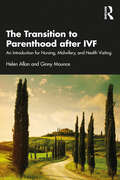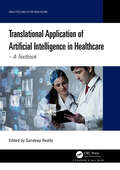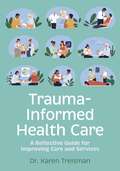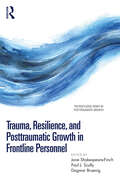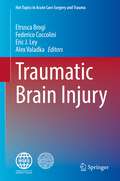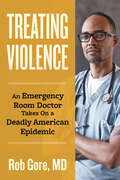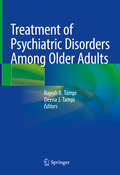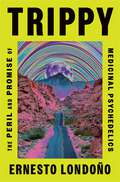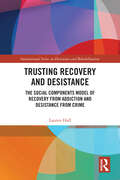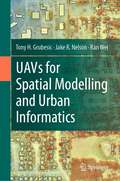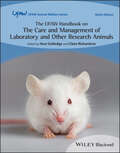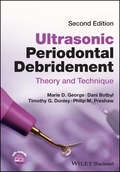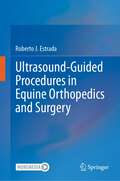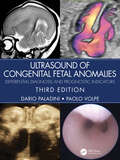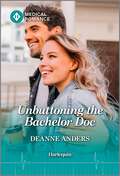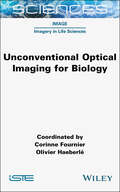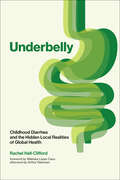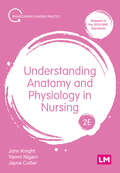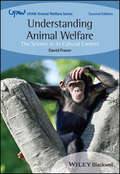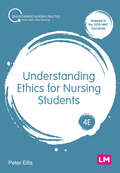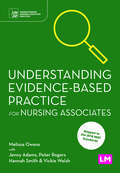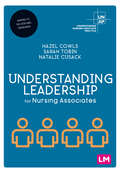- Table View
- List View
The Transition to Parenthood after IVF: An Introduction for Nursing, Midwifery and Health Visiting
by Helen Allan Ginny MounceThis book explores how experiences of IVF can affect the transition to parenthood for non-donor infertile couples. Drawing on empirical research and the broader social sciences literature, the book sets out the context of complex modern family building and discusses how infertility and IVF continue to shape parenthood and family building after successful IVF conception. It looks at how stigma, disclosure, loss, and gender affect the transition to parenthood, as well as what happens when parents start thinking about trying for siblings. We highlight the key roles for health care professionals (nurses, midwives, and health visitors) when caring for these new parents, in providing social support and facilitating good communication to foster emotional well-being. Ideal for nurses and midwives working in reproductive health as well as primary care nurses and health visitors, this applied text is a key reference for all healthcare professionals who meet people at any point on their journey to achieving pregnancy through IVF, during maternity care, and through the first few years of parenthood.
Translational Application of Artificial Intelligence in Healthcare: - A Textbook (Analytics and AI for Healthcare)
by Sandeep ReddyIn the era of 'Algorithmic Medicine', the integration of Artificial Intelligence (AI) in healthcare holds immense potential to address critical challenges faced by the industry. Drawing upon the expertise and experience of the authors in medicine, data science, medical informatics, administration, and entrepreneurship, this textbook goes beyond theoretical discussions to outline practical steps for transitioning AI from the experimental phase to real-time clinical integration. Using the Translational Science methodology, each chapter of the book concisely and clearly addresses the key issues associated with AI implementation in healthcare. Covering technical, clinical, ethical, regulatory, and legal considerations, the authors present evidence-based solutions and frameworks to overcome these challenges. Engaging case studies and a literature review of peer-reviewed studies and official documents from reputed organizations provide a balanced perspective, bridging the gap between AI research and actual clinical practice.
Trauma-Informed Health Care: A Reflective Guide for Improving Care and Services
by Dr. Karen TreismanThis comprehensive reflective resource explores the values, principles and practical applications of trauma-informed and -infused health care. Trauma-Informed Health Care introduces the different types of trauma - including medical and health trauma - and the impact of adversities, social inequalities and stressors. It explores their effects on health and the body, and on people's relationships with health providers. Key issues addressed include the importance of cultural humility, the effects of secondary and vicarious trauma, burnout and moral injury. It also covers the critical issue of organizational trauma: how to avoid practice which has potential to traumatize or retraumatize, and the role of cultural understanding, language, leadership, staff wellbeing and the physical environment.Drawing substantially on the experiences of people who use services and active practitioners, this book spans diverse settings -- from doctor's surgeries to hospitals and allied health services. It reveals how "every interaction can be an intervention" and provides you with practical examples, graphics and reflective exercises to support you to bring about positive change.
Trauma, Resilience, and Posttraumatic Growth in Frontline Personnel (The Routledge Series in Posttraumatic Growth)
by Jane Shakespeare-Finch Paul J. Scully Dagmar BruenigTrauma, Resilience, and Posttraumatic Growth in Frontline Personnel examines the history, context, nature, and complexity of working in front-line services. Chapters provide a detailed overview of specific mental health models that are applicable both on a day-to-day basis and to disaster and major event response. The book also details elements of mental health responses that have been proven to facilitate coping, minimize risk, and promote both resilience and posttraumatic growth. These strategies include, but are not limited to, peer support programs, mental health education, and psychological first aid. Each chapter incorporates research on PTSD, anxiety, and depression as well as research relating to posttraumatic growth, resilience, connectedness, and belongingness. Trauma, Resilience, and Posttraumatic Growth in Frontline Personnel is a vital guide for those who provide care to trauma survivors as well as for researchers and scholars.
Traumatic Brain Injury (Hot Topics in Acute Care Surgery and Trauma)
by Federico Coccolini Eric J. Ley Etrusca Brogi Alex ValadkaIn spite of great improvements in prehospital, critical care, and surgical management, traumatic brain injury is still a leading cause of death and disability resulting in great socioeconomic burden. This book provides a comprehensive and practical perspective of the management of traumatic brain injury, from prehospital setting to discharge. Even more, the book highlights the importance of pathways (Trauma Center and Neurocritical Care Unit) and the central role of the specialized neurocritical care team and neurological critical care units in the practice of neurocritical care. Encouraging a practical, protocol-driven, multidisciplinary approach for both adult and pediatric patients, the authors provide a methodological description of the diagnostic and therapeutic management of patients with traumatic brain injury throughout the patient journey. Neuromonitoring assumes predominant importance, with an increasing role of noninvasive monitoring (near-infrared spectroscopy, Pupillometry, transcranial color Doppler-TCD, transcranial color duplex-TCCD, and optic nerve ultrasound) and neurophysiology (electroencephalography and evoked potentials) for early recognition of complications and rapid assessment of the effectiveness of medical treatment. However, the increasing amount of data increases the complexity of interpreting the collected information. The basic principles of multimodal monitoring and the computer-assisted method are presented to provide an overview of the future direction regarding the integration and interpretation of different data obtained from various techniques.Paying particular attention to prognosis and treatment-limiting decisions, the authors reviewed the critical role of neurorehabilitation and the clinical and bioethical perspective on brain death, organ donation, and communication with the family.
Treating Violence: An Emergency Room Doctor Takes On a Deadly American Epidemic
by Rob GoreThe inspiring story of a Black doctor who was deeply affected by the violence that plagued his Brooklyn childhood and later dedicated himself to addressing trauma and violence as public health issuesRob Gore first encountered violence when he was beaten and robbed as a 10-year old; it was treated as an inevitable fact of life, but after another brush with violence as a teen, he began to reject that prevalent attitude. As he matured and became a doctor, he grew in his determination to find treatments for what he saw not as an unavoidable fact for most people living in vulnerable, underserved neighborhoods especially, but as a public health issue that could be addressed by early intervention and solid support, beginning in the medical community. He also became deeply involved in efforts to diversify the entire field of medicine, starting with the &“front lines&” in the Emergency Department.Seeing his brother Angel and close friend Willis fall prey to the epidemic of violence with profound—and in Willis&’s case—deadly consequences, Rob began seriously researching the issue and went on to found an organization which is one of the models for successful approaches to reducing violence and protecting victims, who are disproportionately BIPOC, living in impoverished neighborhoods, or members of the LGBTQ+ community. Here he provides not only statistics, but stories of what he witnessed in NYC neighborhoods, in Atlanta, Chicago, Buffalo and even in medical work in Haiti and Kenya. His work with the Kings Against Violence Initiate (KAVI) and allied organizations is a blueprint for treating violence not as a police matter, but as a public health crisis, which can and should be addressed and substantially reduced. The people he introduces us to in these pages are not merely victims, but often advocates, paving the way for eliminating the epidemic of violence in our country.
Treatment of Psychiatric Disorders Among Older Adults
by Rajesh R. Tampi Deena J. TampiThis timely book provides detailed information regarding the latest treatment for psychiatric disorders among the growing population of older adults. The World Health Organization reports that between 2015 and 2050, the proportion of the world's older adults (≥ 60 years) will double from about 12% to almost 22% of the total population, and it is estimated that approximately 20% of older adults have a diagnosable psychiatric disorder. Many of these older adults are prescribed psychotropic medications, but these treatments can result in significant functional decline, cognitive decline, cerebrovascular adverse events, and death. The editors, in collaboration with fellow experts in geriatric psychiatry, provide the scientific background regarding the treatment of a range of psychiatric disorders among older adults. The volume features a comprehensive table of contents covering a range of psychiatry subtopics, such as neurocognitive disorders, depressive disorders, substance use disorders, and anxiety disorders. Each chapter adheres to the same easy-to-follow format, and amongst other information, includes evidence-based assessments, non-pharmacological and pharmacological therapies, potential side-effects and their treatments, and evidence-based treatment algorithms for each disorder. Treatment of Psychiatric Disorders Among Older Adults will be a valuable resource for psychiatrists, geriatricians, students, neurologists, advance practice nurses, psychologists, social workers, occupational therapists, physical therapists, and dieticians who care for older adults with mental health disorders.
Trippy: The Peril and Promise of Medicinal Psychedelics
by Ernesto LondoñoA riveting look at the tremendous promise and inherent risks of the use of psychedelics in mental health treatment through the lens of a New York Times reporter whose journalistic exploration of this emerging field began with a personal crisis.When he signed up for a psychedelic retreat run by a mysterious Argentine woman deep in Brazil’s rainforest in early 2018, Ernesto Londoño, a veteran New York Times journalist, was so depressed he had come close to jumping off his terrace weeks earlier. His nine-day visit to Spirit Vine Ayahuasca Retreat Center included four nighttime ceremonies during which participants imbibed a vomit-inducing plant-based brew that contained DMT, a powerful mind-altering compound.The ayahuasca trips provided Londoño an instant reprieve from his depression and became the genesis of a personal transformation that anchors this sweeping journalistic exploration of the booming field of medicinal psychedelics. Londoño introduces readers to a dazzling array of psychedelic enthusiasts who are upending our understanding of trauma and healing. They include Indigenous elders who regard psychedelics as portals to the spirit world; religious leaders who use mind-bending substances as sacraments; war veterans suffering from PTSD who credit psychedelics with changing their lives; and clinicians trying to resurrect a promising field of medicine hastily abandoned in the 1970s as the United States declared a War on Drugs.Londoño’s riveting personal narrative pulls the reader through a deeply researched and brilliantly reported account of a game-changing industry on the rise. Trippy is the definitive book on psychedelics and mental health today, and Londoño’s in-depth and nuanced look at this shifting landscape will be pivotal in guiding policymakers and readers as they make sense of the perils, limitations, and promises of turning to psychedelics in the pursuit of healing.
Trusting Recovery and Desistance: The Social Components Model of Recovery from Addiction and Desistance from Crime (International Series on Desistance and Rehabilitation)
by Lauren HallThe social processes which underpin and shape our lives have the power to significantly transform the trajectories of people experiencing recovery from addiction and desistance from crime. Recovery from addiction and desistance from crime are processes which are often experienced and supported in the same physical spaces and are also frequently experienced by the same people. This book therefore synthesises and presents research on the social influences of recovery and desistance. This book presents the social component model of recovery from addiction and desistance from crime: a strength-based approach presenting case studies to better understand the social factors of both recovery from addiction and desistance from crime and therefore a step towards enhancing evidence-based policy and practice. The social components that have emerged and will be discussed within this book include relationships and social bonds; social identity, group membership, and social networks; and social capital. Compiled based on observations, interviews, and social identity mapping methods, this work combines and presents theory and research to enhance and strengthen the evidence available for people who are already teaching about, supporting, and experiencing both desistance from crime and recovery from addiction in practice.
UAVs for Spatial Modelling and Urban Informatics
by Tony H. Grubesic Jake R. Nelson Ran WeiThis book aims to provide a wide range of real-world applications in using unmanned aerial vehicles (UAVs) for geographic observation, spatial modeling, and urban informatics. Specifically, UAVs are incredibly effective platforms for connecting people, places, and technology. This book explores the utility of UAVs for monitoring, measuring, and improving urban infrastructure systems, urban sustainability, and the urban environment. The dynamism of cities provides opportunities for economic, social, and environmental change, but benchmarking and measuring cities continues to be challenging. This challenge is due, at least in part, to a lack of monitoring systems that can collect and analyze data at a granular enough scale to capture the nuance of local phenomena. UAVs offer a promising mechanism to fill this niche, serving as a measurement platform that can rapidly and inexpensively collect data and monitor change in cities. However, their use is fraught with social, operational, regulatory, and technical challenges for successful deployments. This book provides a resource for urbanists (e.g., planners, geographers, sociologists, epidemiologists, engineers), educators, and students who work with geographic information and seek to enhance these data using data and information from unmanned aerial vehicles. At the same time, we provide operational and methodological frameworks for carrying out these advanced analyses in a manner that considers the challenges of incorporating UAVs in research within the urban environment. We provide six unique applications of UAVs for urban analysis, detailing relevant policy and empirical questions, UAV mission parameters, data collection, spatial modeling, and the associated empirical results. Further, we discuss how best to integrate these results into actionable geospatial intelligence and policy development to improve city infrastructure systems, sustainability, the environment, and neighborhood quality.
The UFAW Handbook on the Care and Management of Laboratory and Other Research Animals (UFAW Animal Welfare)
by Huw Golledge Claire RichardsonThe UFAW Handbook on The Care and Management of Laboratory and Other Research Animals The latest edition of the seminal reference on the care and management of laboratory and research animals The newly revised ninth edition of The UFAW Handbook on the Care and Management of Laboratory and Other Research Animals delivers an up-to-date and authoritative exploration on worldwide developments, current thinking, and best practices in the field of laboratory animal welfare science and technology. The gold standard in laboratory and captive animal care and management references, this latest edition continues the series’ tradition of excellence by including brand-new chapters on ethical review, the care of aged animals, and fresh guidance on the care of mole rats, corvids, zebrafish, and decapods. The book offers introductory chapters covering a variety of areas of laboratory animal use, as well as chapters on the management and care of over 30 different taxa of animals commonly utilised in scientific procedures and research around the world. It also provides: A thorough introduction to the design of animal experiments, laboratory animal genetics, and the phenotyping of genetically modified mice Comprehensive explorations of animal welfare assessment and the ethical review process Practical discussions of legislation and oversight of the conduct of research using animals from a global perspective In-depth examinations of the planning, design, and construction of efficient animal facilities, special housing arrangements, and nutrition, feeding, and animal welfare The UFAW Handbook on the Care and Management of Laboratory and Other Research Animals Ninth Edition is essential for laboratory animal scientists, veterinarians, animal care staff, animal care regulatory authorities, legislators, and professionals working in animal welfare non-governmental organizations.
Ultrasonic Periodontal Debridement: Theory and Technique
by Marie D. George Dani Botbyl Timothy G. Donley Philip M. PreshawUltrasonic Periodontal Debridement A practical and comprehensive reference to all aspects of ultrasonic debridement in periodontal therapy, now fully updated and revised Ultrasonic Periodontal Debridement, Second Edition presents both theory and practice of ultrasonic debridement, including all the information needed to understand this clinical process and apply the knowledge to clinical practice. The Second Edition includes three entirely new chapters and expanded sections in all existing chapters, as well as updating the content and references throughout. The revision greatly expands the number of illustrations and incorporates the most recent advances in periodontal debridement therapy. The book begins with an introduction to the history and principles of ultrasonic technology and technique, then discusses practical guidance for using safe, effective, and efficient ultrasonic periodontal debridement in clinical practice. It is vividly illustrated, with hundreds of images, and emphasizes detailed, step-by-step descriptions. Ultrasonic Periodontal Debridement: Provides a common-sense, easy-to-read approach to topics ranging from pathophysiology to??clinical tips and tricks Features updates to reflect changes to practice and theory, with new chapters discussing??ultrasonic instrumentation for implant maintenance, aerosol transmission, and??aerosol management Presents hundreds of images to accompany the step-by-step descriptions, including images of left- and right-handed clinician-patient positioning specific to the use of ultrasonic instruments Supports dental students, dental hygiene and dental therapy students, practicing dentists, dental hygienists, and dental therapists in understanding and applying concepts related to ultrasonic debridement Ultrasonic Periodontal Debridement is a useful reference for students in dentistry, dental hygiene, and dental therapy, as well as for practicing dentists and dental hygienists and therapists.
Ultrasound-Guided Procedures in Equine Orthopedics and Surgery
by Roberto J. EstradaThis book serves as a practical guide for equine veterinarians in orthopedics and surgery. It reviews and summarizes the current scientific evidence of the most commonly performed ultrasound-guided procedures for ultrasound-assisted surgery and injections.For the first time, different techniques are compiled and richly illustrated with pictures and videos to guide the practitioner step-by-step. An initial discussion about the general principles of ultrasound-guided procedures sets the bases for clinicians to understand the general technique and apply it to each approach. Additional chapters describe the most common ultrasound-guided injections in different anatomical structures as well as the surgical approaches that are aided or guided with ultrasound.All over the world ultrasound-guided procedures are performed daily in many different fields of equine practice. The main objective of using these approaches is to increase accuracy and minimize tissue trauma when performing diagnostic and therapeutic procedures. Equine orthopedics and surgery are among the major applications of these techniques.Learn about ultrasound-assisted techniques and be part of this trend! Maximize your capacity as a veterinarian, directly affecting the health of your patients. You can access the supplementary videos directly on your smartphone or tablet; simply download the Springer Nature More Media App for free and scan the links with the play button.
Ultrasound of Congenital Fetal Anomalies: Differential Diagnosis and Prognostic Indicators
by Dario Paladini Paolo VolpeAn acclaimed overview of ultrasound for the prenatal diagnosis of congenital anomalies returns in a new enlarged edition. In particular, the coverage of both Central Nervous System congenital and acquired anomalies as well as Congenital Heart Disease has been expanded enormously, to make this an impressive comprehensive resource for Fetal Neurology and Fetal Cardiology. Together with additional new chapters on guidelines and protocols, equipment, and disorders of sexual differentiation, and new insight into fetal surgery procedures, this third edition almost becomes three books in one.
Unbuttoning the Bachelor Doc (Nashville Midwives #1)
by Deanne AndersLights, camera, action! Can a midwife and a doctor resist temptation when they&’re forced to be on their patient&’s reality TV show—together? Find out in the first installment of Deanne Anders&’s Nashville Midwives trilogy! MEDICS IN THE SPOTLIGHT! Life has been one big bump in the road after another for midwife Skylar. After moving to Nashville for a fresh start, she immediately clashes with grumpy bachelor Dr. Jared. So she&’s unimpressed when they must feature together on their patient&’s reality TV show! On-screen, they&’re strictly professional. But off camera, she discovers there&’s more to Jared than meets the eye. Can she convince this buttoned-up doc to let loose for once?From Harlequin Medical: Life and love in the world of modern medicine.Nashville Midwives Book 1: Unbuttoning the Bachelor DocBook 2: The Rebel Doctor's Secret Child
Unconventional Optical Imaging for Biology
by Corinne Fournier Olivier HaeberléOptical imaging of biological systems has undergone spectacular development in recent years, producing a quantity and a quality of information that, just twenty years ago, could only be dreamed of by physicists, biologists and physicians. Unconventional imaging systems provide access to physical quantities – phase, absorption, optical index, the polarization property of a wave or the chemical composition of an object – not accessible to conventional measurement systems. To achieve this, these systems use special optical setups and specific digital image processing to reconstruct physical quantities. This field is also known as computational imaging. This book presents various non-conventional imaging modalities developed for the biomedical field: wave front analysis imaging, digital holography/tomography, optical nanoscopy, endoscopy and singlesensor imaging. Experimental setups and reconstruction algorithms are presented for each modality.
Underbelly: Childhood Diarrhea and the Hidden Local Realities of Global Health
by Rachel Hall-CliffordAn unsettling exploration of the hidden power dynamics of global health, seen through the lens of childhood diarrhea and its treatment within the Guatemalan context.Deaths from childhood diarrhea seem preposterous in high-income countries. Yet, for children under five years old in the rest of the world, diarrhea is the third highest cause of mortality. Despite a glut of prevention and treatment programming spanning more than forty years, this least glamorous of global health ills remains a critical problem. In Underbelly, Rachel Hall-Clifford takes a hard look at the pathways of global health funding and development policies and the outcomes they deliver for recipient individuals and communities. Drawing on fifteen years of ethnographic research in highland Guatemala, Hall-Clifford focuses on the provision of primary health care services as a critical exemplar of how global health and development programs fall short.Guatemala has a fragmented health system, the author explains, that guarantees health as a human right but also suffers from systemic racism, inadequate health services and access to those services, community distrust from a legacy of harm and violence, and a demeaning paternalism. Bringing together the discourses of global health and medical anthropology, Underbelly explores the ways in which global health—its actors, structures, and systems—perpetuates the challenges it purports to fix: this is the underbelly. Hall-Clifford argues that global health programs, conceived in offices distant from the places in which they are delivered, often have unintended consequences and contribute to pluralistic and exclusionary health systems that mirror neoliberal economies. She argues that if we are to fix this entrenched crisis of health inequity, we must use the immense resources of global health to center local communities as drivers of change.With a foreword written by Waleska López Canu, an Indigenous Maya medical director, and an afterword by Arthur Kleinman, renowned expert in global health, this book underscores the importance of looking deeper into what seems on its surface incontrovertibly &“good&” to understand the more complex realities on the ground and in people&’s lives.
Understanding Anatomy and Physiology in Nursing (Transforming Nursing Practice Series)
by John Knight Yamni Nigam Jayne CutterCovering all the key aspects of anatomy and physiology that nursing students need to know, this second edition condenses vast amounts of scientific information into short, concise, and easily accessible chapters. It introduces aspiring nurses to all of the vital information on this tricky subject, from an overview of cells, blood, and the major organ systems through to key developmental stages, genetics and ageing. Case studies link core principles of anatomy and physiology to common real-world clinical scenarios, helping students apply this knowledge to their everyday working practice. Key features: - Each short chapter is mapped to the 2018 NMC Standards - Scientific information is broken down into easily digestible chunks with accompanying illustrations, to help aspiring nurses get to grips with this complex subject - Case studies, activities and other learning features help students translate the theory to practice - Provides revision guidance and strategies for tackling exams and assessments
Understanding Anatomy and Physiology in Nursing (Transforming Nursing Practice Series)
by John Knight Yamni Nigam Jayne CutterCovering all the key aspects of anatomy and physiology that nursing students need to know, this second edition condenses vast amounts of scientific information into short, concise, and easily accessible chapters. It introduces aspiring nurses to all of the vital information on this tricky subject, from an overview of cells, blood, and the major organ systems through to key developmental stages, genetics and ageing. Case studies link core principles of anatomy and physiology to common real-world clinical scenarios, helping students apply this knowledge to their everyday working practice. Key features: - Each short chapter is mapped to the 2018 NMC Standards - Scientific information is broken down into easily digestible chunks with accompanying illustrations, to help aspiring nurses get to grips with this complex subject - Case studies, activities and other learning features help students translate the theory to practice - Provides revision guidance and strategies for tackling exams and assessments
Understanding Animal Welfare: The Science in its Cultural Context (UFAW Animal Welfare)
by David FraserUnderstanding Animal Welfare The essential text on understanding and improving animal welfare Understanding Animal Welfare, 2nd Edition is revised and expanded to incorporate new research and developments in animal welfare. Updated with greater accessibility in mind, the reader is guided through animal welfare in its cultural and historical context, methods of study, and applications in practice and policy. Drawing examples from farm, companion, laboratory and zoo animals, the text provides an up-to-date overview of research and its applications, while also tracing how concepts and methods have evolved over time. Readers of the second edition of Understanding Animal Welfare will also find: New developments in understanding positive animal states The importance of human actions in determining animal welfare New content on “One Welfare” How free-living wild animals are affected by human technology and climate change Originally intended for scientists and professionals, Understanding Animal Welfare has also found a home in undergraduate classrooms. It is now the essential text for students, practitioners, veterinarians, and researchers in animal welfare and related fields.
Understanding Ethics for Nursing Students (Transforming Nursing Practice Series)
by Peter EllisEthics have an significant impact on the decisions nurses make in their day-to-day work, so it’s important for all student nurses to develop their understanding of ethical frameworks as preparation for future practice. In this book, the author explains ethical ideas, theories and concepts in simple to understand terms, focussing on real-life nursing situations in order to make applying these principles to practice easy. This book will make student nurses consider their own values, and how ethics fit into who they are and how they behave, helping them to unlock this interesting and complex subject. Key features: Fully mapped to the NMC Future Nurse standards of proficiency (2018) A practical guide that explores how ethics applies to nursing and shows you how the theory fits in to the realities of practice Contains real work case studies with an emphasis on ethical decision making Activities challenge students to reflect on their own values, experiences and prejudices and to think about how ethics fits in with who they are and how they behave
Understanding Ethics for Nursing Students (Transforming Nursing Practice Series)
by Peter EllisEthics have an significant impact on the decisions nurses make in their day-to-day work, so it’s important for all student nurses to develop their understanding of ethical frameworks as preparation for future practice. In this book, the author explains ethical ideas, theories and concepts in simple to understand terms, focussing on real-life nursing situations in order to make applying these principles to practice easy. This book will make student nurses consider their own values, and how ethics fit into who they are and how they behave, helping them to unlock this interesting and complex subject. Key features: Fully mapped to the NMC Future Nurse standards of proficiency (2018) A practical guide that explores how ethics applies to nursing and shows you how the theory fits in to the realities of practice Contains real work case studies with an emphasis on ethical decision making Activities challenge students to reflect on their own values, experiences and prejudices and to think about how ethics fits in with who they are and how they behave
Understanding Evidence-Based Practice for Nursing Associates (Understanding Nursing Associate Practice)
by Melissa Owens Jenny Adams Peter Rogers Hannah Smith Vickie WelshProviding evidence-based care is fundamental to working safely and effectively as a nursing associate. This book equips you with the skills to identify, evaluate and apply evidence and research to your practice. From day-to-day procedures and decision-making, to addressing health inequalities and implementing service improvement, it develops your confidence in using evidence to underpin all aspects of your role. Key features - Fully mapped to the NMC Standards of Proficiency for Nursing Associates (2018) - Explains the principles of evidence-based practice in clear, straightforward language - Case studies and activities illustrate evidence-based practice across a range of different patient groups and care settings - Written specifically to address the unique experiences, challenges and requirements of the nursing associate role
Understanding Evidence-Based Practice for Nursing Associates (Understanding Nursing Associate Practice)
by Melissa Owens Jenny Adams Peter Rogers Hannah Smith Vickie WelshProviding evidence-based care is fundamental to working safely and effectively as a nursing associate. This book equips you with the skills to identify, evaluate and apply evidence and research to your practice. From day-to-day procedures and decision-making, to addressing health inequalities and implementing service improvement, it develops your confidence in using evidence to underpin all aspects of your role. Key features - Fully mapped to the NMC Standards of Proficiency for Nursing Associates (2018) - Explains the principles of evidence-based practice in clear, straightforward language - Case studies and activities illustrate evidence-based practice across a range of different patient groups and care settings - Written specifically to address the unique experiences, challenges and requirements of the nursing associate role
Understanding Leadership for Nursing Associates (Understanding Nursing Associate Practice)
by Hazel Cowls Sarah Tobin Natalie CusackDemonstrating leadership is entwined with many aspects of the nursing associate role. It is found in your workload management, prioritisation and delegation. It is found in the way you contribute to your team and supervise others. It is found in the way you deliver care and implement quality improvement. In short, understanding leadership is key to your future career. This book offers a first step into the world of leadership. Introducing the theory and principles of leadership you need to know, it shows you how to apply them to your every day role and build confidence in yourself as a leader. Key features - Fully mapped to the NMC Standards of Proficiency for Nursing Associates (2018) - Explains the theory and principles of leadership in clear, straightforward language - Case studies and activities illustrate leadership across a range of scenarios and care settings - Written specifically to address the unique experiences, challenges and requirements of the nursing associate role
